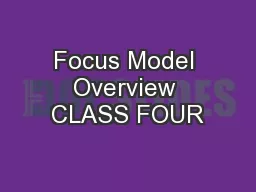

Denver Regional Council of Governments July 7 2011 Tentative Schedule Model Steps July 7 Final Model Steps How to Run the Model July 14 Theoretical Underpinning July 21Erik Model Steps ID: 713714
Download Presentation The PPT/PDF document "Focus Model Overview CLASS FOUR" is the property of its rightful owner. Permission is granted to download and print the materials on this web site for personal, non-commercial use only, and to display it on your personal computer provided you do not modify the materials and that you retain all copyright notices contained in the materials. By downloading content from our website, you accept the terms of this agreement.
Slide1
Focus Model OverviewCLASS FOUR
Denver Regional Council of GovernmentsJuly 7, 2011Slide2
Tentative Schedule
Model Steps July 7Final Model Steps/How to Run the Model July 14
Theoretical Underpinning July 21(Erik)
Model Steps/
SQL Database July 28
???? August 4
Should we continue after this?
Slide3
Classes are posted on the website
http://www.drcog.org/index.cfm?page=FocusTechnicalResourcesOr google
Focus travel modelSlide4
Brief Interlude in the Model Steps to show operations of model
This will probably change.Show scenario creation & scenario running.QuestionsSlide5
Focus Model Flow: 28 Steps
Outside The Speed Feedback Loop: Run Once-
STAGE 1
GISDK called from C#:
GISDK Preprocess
Java:
3
. Population Synthesizer
C#
4.
PopSyn
Output Processor
5. Size Sum Variable Calculator
STAGE 2 GISDK called from C#:For DIA, I-E, E-E and Commercial Trips1. DRCOG Multi-Period Highway Preprocess 2. DRCOG Multi-Period Transit Preprocess3. DRCOG Transit Preprocess4. Trip Generation5. Highway and Transit Skimming6. Trip Distribution7. Mode ChoiceSTAGE 3 C# Regular Trips8. Regular Work Location Choice 19 . Tour Main Mode Choice 9. Regular School Location Choice 20. Tour Time of Day Choice10. Auto Availability 21. Intermediate Stop Generation11. Aggregate Logsum Generation 22. Trip Time of Day Simulation12.Daily Activity Pattern 23. Trip Time Copier13. Exact Number of Tours 24. Intermediate Stop Location14.Work Tour Destination Type 25. Trip Mode Choice15.Work-Based Subtour Generation 26. Trip Time of Day Choice16. Tour Time of Day Simulation 27. Write Trips to TransCAD17. Tour Primary Destination Choice18. Tour Priority AssignmentSTAGE 4 GISDK called from C#:28. Highway and Transit Assignment
FEEDBACKSlide6
Focus Model Flow
FEEDBACKSlide7
Long term choices made
Each individual has regular work location, school location. We know how many cars a household has and how it accessible it is to various types of services.
Now we need
daily choices
for travel. How many trips will each person take and for what purposes?Slide8
HOME
WORK
STORE
Next we generate tours and information about location, mode, and time.Slide9
Tour Generation Models
We generate a number of tours
for seven purposes. We find out if each person has
stops
for each purpose
Then we look at if people go to their
regular workplace or someone else
. We see how many
work-based
subtours
they take.Slide10
Tours get written into the database.Slide11
Now we need to know more information about the tours
16. Tour Time of Day Simulation (When) 17. Tour Primary Destination Choice (Where)
18. Tour Priority Assignment (Priority)
19 . Tour Main Mode Choice (Mode)
20. Tour Time of Day Choice (Time) Slide12
Tour Time of Day Simulation
Tour Time of Day Simulation: Type of Model = Monte CarloThis is a weird one!Before we pick where a person goes and which mode they use on a tour we need a skim time period to pick from to choose how long it takes
We use a weighted random assignment of the TOUR DESTINATION ARRIVAL TIME/ TOUR DESTINATION DEPARTURE TIME based on the purpose of the tour.Slide13
Tour Time of Day Choice Example
HOME
STORE
WORK
Arrive at Tour Primary Destination at 8 am,
Leave at 5 PM
Then the tour gets assigned, the AM Peak skim for 8 am on the outbound, and the PM peak skim on the inbound tour halfSlide14
Let’s talk about ourselves again (volunteer)
Other than for work or school, where do you go (to the level of detail of an X-Y
coodinate
) on a typical weekday?
Why? What variables about you, the
transporation
network, where you live, or where you work determine this?Slide15
Tour Primary Destination Choicethis is hard!
Predicts: Zone and X,Y Location of Tour Primary Destination
Model Type: Multinomial
Logit
Inputs: (what do you think)
Tour Purpose
Number of Jobs by Type
Tour Time of Day
Number of Jobs by Type
Person Age
Income
Distance/Accessibility
from Home to DestinationSlide16
Then we know where the tour starts and ends.Slide17
Tour Priority Assignment
What is the rank order of the tours in your day? From most important to least important. This helps determine which tours get their mode and time assigned first.For example for full time workers, the most important tour is the first one to work. For students,
it’s the first one to school.